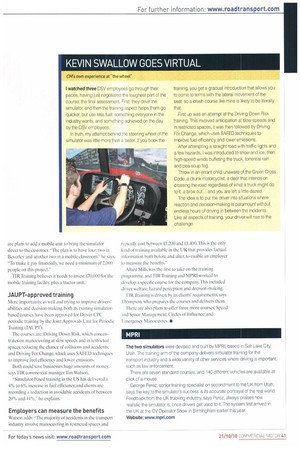KEVIN SWALLOW GOES VIRTUAL
Page 41

If you've noticed an error in this article please click here to report it so we can fix it.
Utfs own experience at "the wheel" I watched three DSV employees go through their paces, having just negotiated the toughest part of the course, the final assessment. First, they drive the simulator, and then the training aspect helps them go quicker, but use less fuel: something everyone in the industry wants, and something achieved on the day by the DSV employees.
In truth, my attempt behind the steering wheel of the simulator was little more than a taster. If you book the training, you get a gradual introduction that allows you to come to terms with the lateral movement of the seat, so a crash course like mine is likely to be literally that.
First up was an attempt at the Driving Down Risk training. This involved anticipation at slow speeds and in restricted spaces, it was then followed by Driving For Change, which uses SAFED techniques to improve fuel efficiency and lower emissions.
After attempting a straight road with traffic lights and a few hazards, I was introduced to snow and ice, then high-speed winds buffeting the truck, torrential rain and pea-soup fog.
Throw in an errant child unaware of the Green Cross Code, a drunk motorcyclist, a deer that intends on crossing the road regardless of what a truck might do to it, a blow out... and you are left a little dazed.
The idea is to put the driver into situations where reaction and decision-making is paramount without endless hours of driving in between the incidents. Like all aspects of training, your driver will rise to the challenge.




























































































































